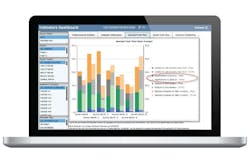I hear it everywhere I go: Sales are slow. We can’t get enough work. We can’t find the jobs. We can’t close enough sales.
Sounds familiar, right? The vast majority of shops across the country have a burning desire to increase sales. Most of them could do so, almost instantly, by paying attention to one key performance indicator (KPI): assignment-received to estimate-start date cycle time.
If you’ve never heard of it, don’t worry; you’re not alone. If you have heard of it and are effective at tracking it and maintaining strong results … well, you’re actually pretty alone on that. To put it bluntly: This is something the industry, as a whole, struggles greatly with. And most shops don’t even realize it.
So, what does it mean? Assignment-received to estimate-start date (let’s call it AED) refers to the amount of time it takes from the date you receive an assignment from an insurance carrier or through your estimating system to the time it takes you to complete the estimate.
It’s pretty simple, and seeing as these are jobs that are literally handed to you, we should expect some pretty stellar numbers, right? Nope. Between 20 Groups and private clients I see these numbers from hundreds of shops. Most shops average right at five days for this. That’s horrible, just horrible.
Meanwhile, best-in-class shops turn these around in less than 2.2 days. Most of those shops are MSOs.
And this is something that insurance carriers are paying very close attention to, recently. Insurers have found that there is a direct correlation between how long it takes a shop to get in touch with a customer and perform an estimate to how much they wind up paying in bodily injury claims. That’s a big deal to them, and how you perform in AED could affect your standing with those carriers.
Now, there might be some people saying, “But, Mike, I’m not a DRP shop. This doesn’t apply to me.” You’re wrong. If you’re receiving assignments through an estimating system, like CCC’s Open Shop or Mitchell’s Repair Center Connect, those are free business leads. And if you’re not monitoring and achieving strong results in AED, you’re wasting those; you’re wasting money.
OK, so what should you do? First off, you need to track that KPI. Start now. Don’t wait. If you have CCC ONE, you already have the ability to track it, whether you know it or not. (See the accompanying screenshot for where to find it in the system.) CCC even allows you to compare against the average shops in your market. If you don’t have CCC, this is something that is very simple to add to your basic reports. All you have to track is the time and date of when an assignment comes in, and the time and date of when the estimate was performed. It’s as simple as that.
Now that you’re tracking it, you need to ensure that you’re hitting the proper benchmarks. The shops that have an AED of less than 2 days all follow similar tactics. For MSOs, this is why they have call centers; they’re not there to update customers on the repair status, but rather to have someone available to call a customer as soon as an assignment comes in. The best MSOs average just 7 minutes between getting an assignment and getting the customer on the phone. That’s huge if you’re trying to get the estimate done in the next 36 hours, especially when a number of them offer mobile estimating.
If you don’t have a call center, the first step is to make sure you have someone in your organization responsible for monitoring those assignments and getting in touch with customers. Then, create a standard operating procedure for doing this—everything from the pecking order of who’s responsible to how often to check (for a single-shop independent, I’d recommend checking every hour), reminders in place for checking (Outlook works well), and a word track for calling the customer and getting the vehicle into your shop.
When you do this and have your AED getting lower and lower, you’ll see a direct correlation in the amount of jobs you captured. Imagine being a consumer: You get in a car accident, notify your insurance company, and then you’re supposed to wait five days for a shop to call you? As a shop, you likely lost that customer, or at the very least, under whelmed them. This KPI is critical from an insurance standpoint. It’s critical in providing high-level customer service. And when it’s clicking, it will increase your sales and bottom line.
When I walk into a shop and hear those common refrains about lack of work and slow sales, the first thing I do is look at AED. That’s the very first thing. And why not? It’s a very simple way to improve your business. This industry can be tough—far too tough to miss out on work handed right to you.




